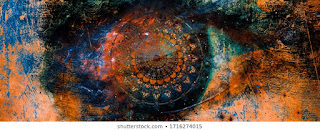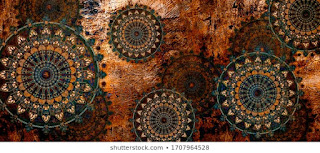The various parts of Vedic writing had outgrown each other.
The four Vedas were trailed by the Brahmanas, the Aranyakas, and the Upanishads. The Brahmanas clarify in detail different Vedic conciliatory functions and their roots. It is the most punctual of the Aryan's writing.
The Aranyakas contains the philosophical and magical substance. They are called so on the grounds that their substance necessitated that they should be concentrated in the disengagement of the woods (aranya). They are the end bits of the Brahmanas.
In the last period of the Vedic writing, Upanishads were reasoned structure the custom of the Aranyakas.
The Apparatus Veda manages Karmakanda (ceremonial) and philosophical viewpoints.
The Brahmanas contains the ceremonial viewpoint.
The Upanishads contains the logical angle.
Chhandogya and Brihadaranyaka are the two most established and generally significant of types of the Upanishads.
Other significant Upanishads incorporate Kathak, Isa, Mundaka, Prasna, and so on
Topography and New Political States
The primary settlement of the Apparatus Vedic individuals was the district of Indus and Saraswati Valleys. In any case, during the later Vedic period, Samhitas and Brahmanas specifies that the settlements covered basically the entire of northern India.
The Ganga stream, when, involved the pleased spot of the most adored and consecrated waterway of India. In this way, the focal point of progress currently moved from Saraswati to Ganga.
There was surprising improvement in steady extension and union of Vis.
Jana known in Apparatus Vedic period like Bharatas, Purus, Tritsus, and Turvasas were gradually converging with other Janas and vanished from the scene. Individuals of Rear-end, Druhyus, Turvasas, the Krivis, were likewise disappeared.
The states, in particular Kasi, Kosala, Videha, Magadha, and Anga created in the eastern Uttar Pradesh and Bihar. In any case, the zones of south India are not plainly referenced.
The battle for matchless quality among various states was of successive event. The ideal of general domain showed up.
Satapatha Brahmana referenced the extension of individuals towards the east. It referenced Videgh Madhav moved from the place where there is Vedic Culture (Saraswati Valley) and crossed Sadanira (current Gandak Stream) and the eastern limit of Kosala and went to the place where there is Videha (present day Tirhut).
The development of three realms, in particular Kosala, Kasi, and Videha occurred. From that point, the unearthings at Hastinapur, Atranjikhera, and numerous different locales have uncovered societies going from 2,000 B.C. onwards.
Some trait of the stoneware of post Harappan period were seen as Ochre Hued Ceramics (O.C.P.) (c. 2,000-1,500) and during c. 1,200-600 B.C., Dark and Red product, Painted Dim Product and so on were taken note.
Northern Dark Cleaned (N.B.P.) product came to be fabricated about seventh century B.C.
The Kuru-Panchala locale is referenced in the Upanishads as the seat of culture and success. It was the locale of present western and focal Uttar Pradesh.
Three realms of Kosala, Kasi, and Videha referenced as the seats of Vedic culture.
Magadha and Anga were likewise referenced as removed terrains in the Atharvanaveda.
In the south, Vidarbha (in Maharashtra) was referenced.
The conditions of Bahlikas, Kesins, Kekayas, and Kamboja were arranged in the further west to Punjab.
Country and Organization
With the developing idea of states, authority turned into the ordinary type of government. The majesty was being given the status of heavenly source.
Terms like adhiraj, rajadhiraja, samrat, and ekrat were utilized in a large portion of the content alludes to the idea of a ruler of lords.
The term ekrat characterized in Atharvanaveda, alludes the principal sovereign.
Exceptional services were coordinated for the arrangement of rulers, for example, the Vajpeya, Rajsuya, and Ashvamedha.
The government was set up on the firm establishments. It was not outright, but rather restricted severally.
Certain vote based components were working inside the system of majesty. These were −
The individuals' privilege in picking their lord;
The conditions forced on lord's privileges and obligations;
The lords reliance on the chamber of his clergymen; and
The gatherings of individuals, sabha, and samiti, as check after lord's absolutism.
The lord, by no means, be considered as the sole proprietor of the realm with total control over the items and subjects.
The lord was holding the realm as a trust. He should be just a trustee and hold it depending on the prerequisite that he would advance the individuals' well-creatures and progress.
Sabha
Sabha and Samiti assumed significant job in the organization alongside the pastors and authorities,
The sabha worked as a parliament for removal of public business by discussion and conversation.
The Head of the sabha was called as the sabhapati, the attendants as sabhapala and the individuals as sabheya, sabhasad, or sabhasina
Rules were outlined to oversee the discussion in sabha.
Sabha likewise went about as an official courtroom as it is said that "one who goes to the Sabha sits as a law court to administer dharma Equity".
Samiti
Samiti was the bigger General Get together of individuals and it was not the same as Sabha as far as capacity and piece. The Sabha was a more modest chose body, which worked as the lower court.
Because of expansion in multifaceted nature of the general public and political structure, some new authorities were delegated by the state in particular −
Suta (charioteer),
Sangrahitri (financial officer),
Bhagadugha (gatherer of assessments),
Gramini (top of a town),
Sthapati (boss appointed authority),
Takshan (woodworker),
Kshatri (chamberlain), and so on
The regulatory apparatus was exceptionally coordinated and turned into a proficient instrument for administering over a huge realm.
Lawful organizations turned out to be more engaged. The ruler regulated equity and used the pole of discipline.
Insignificant offenses were left to "town judges."
The disciplines for the wrongdoing were fairly serious.
For proof, the onlooker was a higher priority than witness.
The law was likewise extremely clear on the topic of legacy of property, responsibility for, and so forth
The dad's property was acquired by children alone.
The little girls could acquire it just in the event that she was the lone youngster or there were no male issues.









0 Comments